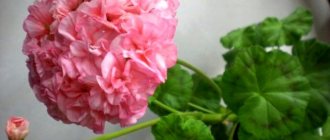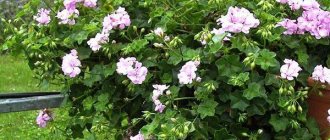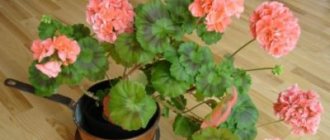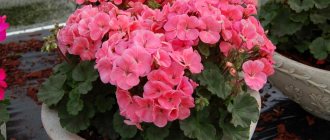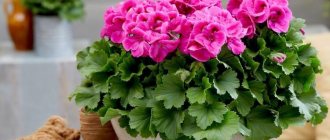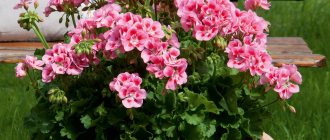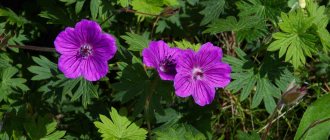A wonderful indoor flower is geranium or it is also called pelargonium or kalachik.
In the 20th century, this flower was very popular, but today it has gone a little into the shadows.
it was replaced by violets, gloxinias, and other indoor plants.
Geranium is considered a bit old-fashioned. But is it?
The plant always pleases the eye and delights with its luxurious flowers.
Thanks to the grandmothers who sell at the market, this flower can always be found on sale.
Pelargonium takes me back to childhood, when it grew on almost every window.
Kalachiki plant (geranium, pelargonium): home care, photo + video
Today we will talk about rolls or geraniums (pelargonium), which have been the most famous and popular home ornamental plants for many years.
I also have such flowers in my flower collection, and over time I began to grow quite a lot of varieties. The rolls are very unpretentious, the flowering is magnificent, and care is quite simple. Of course, there are some peculiarities in care, but they are simple, and even a novice gardener can grow such a plant. I want to share my experience of caring for rolls or geraniums at home.
Why should this plant be grown in every home?
This is not only a beautiful flower, but also useful. A high concentration of essential oils in the plant saturates the air with useful substances, which has a positive effect on the well-being and condition of household residents. But that's not all. Pelargonium oil helps relieve migraines and toothaches. To do this, the painful area must be lubricated with the product.
The essential oils contained in the plant help in freshening and disinfecting the air, as well as eliminating harmful microbes. Pelargonium extract is added to massage oil. It enhances the warming effect and helps relieve muscle pain and neuralgia. But we have an article on our website about how to use geranium to treat various ailments.
Description and photo of geranium varieties
Geranium or cranebird (lat. Geranium) is a herbaceous or semi-shrub perennial plant belonging to the Geraniaceae family, reaching a height of fifty centimeters or more. Often this name also means “pelargonium”, a plant from the same family and very similar.
The plant is endowed with a branched powerful root system, rigid erect or creeping stems, dissected or lobed green or greyish, bluish, reddish leaves, large purple, white, blue or violet single flowers collected in racemose inflorescences.
The birthplace of the flower is South Africa. The genus has about four hundred species.
There are about 400 plant species in total. The most popular, beautiful and easy to care for include: royal (photo 1), ampelous (photo 2) and fragrant geranium (photo 3). Most often in home floriculture, zonal geranium or “kalachik”, as it is also called, is used. A characteristic feature of this variety is dark concentric circles on the leaves. Zonal geranium can reach a height of sixty centimeters or more. The flowers are double or simple, bright crimson, red, white or purple (photo 4).
Short description
Everyone knows this plant and loves it. In total, more than 400 species of rolls are known in the world, which can be annual or perennial. Almost all varieties bloom for almost a whole year and are a decoration for any interior.
Advantages of rolls (geraniums)
- Some time ago, this plant lost popularity due to the appearance of other exotic flowers, but now it is again regaining its leading position in home flower collections of gardeners. Geranium has a number of undeniable advantages.
- Firstly, this is a brightly flowering beautiful plant that has a long flowering period and does not require special care.
- Secondly, the rolls have a specific aroma and healing properties. The smell drives away many pests, including indoor ones.
- Kalachiki can be grown both indoors and in the garden. There are a lot of varieties, and you can choose to suit every taste. The plant was brought from South Africa. From the 15th to 16th centuries it became a favorite, first in the homes of aristocrats, as a decorative and elegant plant, and then gained popularity among all segments of the population.
Features of cultivation - general recommendations
- In winter, this flower needs to be kept at a cooler air temperature than in other months of the year. However, it should not be less than +10 degrees.
- Unlike many indoor flowers, kalachiki (geranium) is not afraid of the sun and loves it very much. You can place this flower on the south side, and it will delight you with lush greenery and beautiful inflorescences.
- The plant is exotic and tropical, so it can delight its owners with flowering almost 365 days a year. To do this, you need to provide good care and the right amount of light.
- In order for the bush to grow in breadth and be fluffy, you need to periodically pinch the tops of the branches. Flowers that have bloomed should be removed immediately so that they do not take nutrients from the plant. Plants also need pruning.
- Kalachiki rarely get sick, and the cause is poor care and excessive watering. Gray rot and black leg are a consequence of waterlogging of the soil.
Features of cultivation
Geranium is one of the most popular indoor plants that does not require any special effort or time to grow. However, there are several features that an amateur gardener would do well to know about caring for homemade geraniums:
- In winter, geranium likes cool temperatures, but you should not keep it in a room with a temperature below 10 ºC;
- The geranium flower loves the sun, so the best place for a pot of geranium is a south window;
- geranium can bloom all year round, for this it only needs sufficient food and light: do not forget that its homeland is South Africa;
- To enhance branching, geranium shoots need to be pinched;
- wilted flowers must be removed;
- Almost all types of geraniums require regular pruning.
We care for rolls (geraniums, pelargoniums)
As already mentioned, care is the simplest and minimal, but if you do everything correctly, the plant will bloom constantly and will have a healthy appearance and a lush crown.
Place
- The main rule is that there should be a lot of sun, the south side is the ideal place for the plant. Only on very hot and dry days can you shade the window a little so that the leaf plates do not get burned.
- If you place the plant in the shade or in a damp corner where windows open and there are drafts, the balls will react with yellowing leaves and a lack of flowering.
Watering
It is strictly not recommended to water the rolls with cold tap water containing a high content of chlorine and lime. Only warm water is used, which is pre-settled. You can use filtered.
During the autumn and winter months, watering is carried out several times a week as the top layer of soil dries. On hot summer or spring days, water the soil in the pot daily. But you can’t overfill it, so that the root system doesn’t start to rot.
Be sure to make a drainage layer in the flowerpot where the geranium grows so that moisture does not stagnate in the root system. The pot is not very large in size. It is necessary that the roots completely occupy the entire volume. In a pot that is too large, the flower will not bloom until the root system grows.
Humidity
- This plant does not tolerate spraying or showering. Also, do not wipe the foliage with wet wipes. This procedure can only be carried out very rarely when the flower becomes too dusty. High humidity has an extremely negative effect on the rolls.
- If there are plants nearby that need increased moisture and spraying, then try not to get on the geranium.
Temperature
Kalachiki grow well at normal room temperature throughout the year. In the autumn - winter period, the air temperature should be within +10 - 15 degrees. It is worth moving the pot with the balls to the windowsill or to a room that is not so heated.
Fertilizers
- It is strictly not recommended to add organic matter to the soil. Geranium tolerates it extremely negatively.
- During the growing season (growth and flowering), you need to apply fertilizers for indoor flowering plants. The scheme is no more than several times every 30 days.
- Fertilizers are applied in liquid form. It is advisable to combine it with watering.
- During the development period and for longer and more abundant flowering, you can use the following feeding recipe: dissolve 1 drop of regular iodine in 1 liter of water. You need to water along the walls of the pot so as not to burn the root system.
Trimming
- This procedure is usually carried out in the autumn. Leave shoots that should have only 6 - 8 leaves.
- It is necessary to remove branches that grow not from the soil, but from the axils of the leaf blades.
- In the third ten days of February and until the beginning of March, pruning can also be done. Remove the branches and leave only a few buds on the shoots.
- Use the branches that you cut for propagation. Makes excellent cuttings.
- If you want to make the bush of balls more luxuriant and denser, pinch out the top parts of the branches, leaving 4 - 5 leaves.
- In winter, pruning is not carried out.
Varieties of zonal geranium
Coral
- Meteor and Reformer (bright red, simple)
- Coral, Ruby (bright red, double)
- Fisher is a modern variety, distinguished by additional semi-double petals, red-pink.
- Saxony is a wide spreading bush with tall dense stems, the color of the flowers is bright red.
- Salma is a compact bush with very large bright red buds.
Large-flowered
- My ideal;
- Balcony (pink).
Ivy-shaped
White Pearl (white), Garden Slava (double, bright red), Roland (semi-double raspberry).
Geranium, especially fragrant, releases phytoncides that disinfect the air, killing pathogenic microbes.
In ancient times, pelargonium was considered the flower of the poor for its ability to disinfect dry and musty air in the homes of artisans.
The aroma of geranium leaves calms, improves sleep, and strengthens the nervous system.
Blooming pelargonium, planted in the same pot with other plants, creates a unique holiday that lifts your spirits.
How to replant rolls
The flower does not really need such a procedure. In addition, the rolls do not like to be transplanted, so this event should not be carried out too often and unless absolutely necessary.
The plant needs to be replanted only when the roots begin to peek out of the pot. It is recommended to plant or replant a flower only in the first half of spring, when the growing season begins.
Choose a new pot that is only a few centimeters larger than the previous one. In a pot that is too large, flowering will not occur soon.
Be sure to place a layer of drainage at the bottom of the flowerpot, and then fill it with regular universal soil for flowers. You can only use garden or vegetable soil.
Transplantation
For better flowering when caring for geraniums, replanting is recommended. But only in the case when its roots require more volume in their development or when there is an accidental overflow of water during the irrigation process. When replanting, it is necessary to take into account that the balls do not like spacious pots.
When placing a flower in a new pot, you must ensure good drainage to avoid water stagnation after watering, otherwise the roots may rot. There is no need to add any special ingredients to the geranium substrate. Ordinary soil, which can be purchased in a store, or even just soil from the garden is well suited for it.
Reproduction methods
There are several basic methods that gardeners use when breeding rolls. Let's see what is needed for these events.
Seed method
- Unlike many plants, this option for propagating geraniums does not present any difficulties at all. The seed material germinates very well and the germination rate is almost 100%.
- If you plant seeds from balls that you have at home, the grown plant will differ from the mother plant, as it will lose its varietal characteristics. This is especially true for hybrids.
- You can prepare a nutritious soil mixture yourself, mix the following components: 1 part - peat, 1 part - river sand, 1 part - turf soil. Before planting, you need to moisten the soil. After planting, sprinkle the seeds on top with the same soil. You can sprinkle a layer of moistened sand no more than 1.5 cm.
- Before planting, the soil is disinfected with a solution of potassium permanganate so that the rolls do not get sick with such a dangerous disease as “blackleg”.
- Next, the planted seeds are covered with film or glass and the temperature is maintained at +18 - 20 degrees. When the seeds germinate, the shelter must be removed and the temperature reduced slightly to +16 - 20 degrees. Place the container in a sunny place.
- After 2 months, several independent adult leaves will grow. Then you need to carry out the picking procedure, that is, plant the sprouts in separate small pots.
- If there are 5 - 6 leaves, it is advisable to pinch the upper parts of the shoots so that the crown becomes lush and grows.
Cuttings
- Sprouts can be harvested after pruning and throughout the year. But the strongest cuttings will be those cut in the spring.
- Their length should be 7 - 8 cm, leave a few leaves on each. Next, dry the sprout for 24 hours, and treat the cut area with finely crushed activated carbon.
- Then plant the sprout in a nutrient substrate. It should be very loose; you can even use moistened sand.
- When moistening the substrate, avoid getting moisture on the leaves and stems of the plant. The room temperature should be about 22 degrees Celsius.
- There is no need to cover the cuttings. When the cuttings take root, they are then transplanted into permanent pots.
Using mallow in cooking
The properties of mallow herb are used not only in health recipes, but also in the kitchen. Soups are prepared from the leaves of the plant, added to cabbage rolls instead of cabbage, boiled and consumed with feta cheese or hard cheese. The greens of the perennial plant are used in okroshka and improve the taste of regular scrambled eggs.
Mallow salad
You can make a low-calorie, tasty and healthy salad from perennial leaves. The ingredients you will need are the following:
- onions - 50 g;
- fresh mallow leaves - 300 g;
- 100 g carrots;
- 50 g each of horseradish and mayonnaise;
- dill, parsley and salt to taste.
Making the salad is very simple - blanch the mallow leaves in boiling water for 5 minutes, then cut them and pour them into a glass container. Chopped onions and carrots, grated horseradish are also added there. The salad is salted according to your own preferences, seasoned with mayonnaise, and topped with dill and parsley.
The properties of a carrot-green salad with mallow will help raise your tone and strengthen your immune system.
It takes very little time to prepare the dish - only about 10 minutes. And the salad brings significant benefits, since it saturates the body with vitamins and minerals from vegetables and herbs.
Herbal caviar from mallow
You can prepare unusual caviar from the fresh leaves of a perennial plant. The process will require additional ingredients, namely:
- nettle - 40 g leaves;
- sorrel - 30 g;
- 2 small cloves of garlic;
- 25 g onions;
- salt and ground black pepper to taste;
- 25 g tomato sauce and 15 ml olive oil.
Herbal caviar from mallow, nettle and sorrel is an unusual dish with many valuable properties
To prepare caviar, you need to thoroughly wash the leaves of the plants and blanch them for a minute. Then the greens are loaded into a blender and chopped properly, sautéed and onions are added. The whole mixture is poured with tomato paste and sprinkled with pepper and grated garlic and salt. At the last stage, the ingredients are sent to a saucepan or deep saucepan and simmered for another 15 minutes on the lowest heat.
Types of pelargonium.
Pelargonium is one of the most popular potted plants for the home. Often in everyday life it is called geranium or kalachik, although in fact they are not the same thing. Pelargonium zonalis is more common in home floriculture. It can bloom throughout the year and does not have a pronounced dormant period.
There is an unimaginable number of varieties of zonal geraniums. They differ in height, color, shape, etc. Depending on the shape of the flowers, double, non-double and semi-double varieties are distinguished. Ampelous geranium is also quite widespread in indoor floriculture. It is used for landscaping balconies and loggias, as well as for growing in hanging pots.
Royal pelargonium deserves special attention. It is more demanding in terms of maintenance conditions, but is distinguished by greater decorative appeal due to large flowers of heterogeneous color.
Spreading
Mallow can be found in almost every corner of the world, with the exception of the desert and the Arctic. Mallow grows in temperate and subtropical zones. Some species are found in the tropics. Mallow grows in gardens and parks, in swamps and along the edges of rivers and lakes. Prefers bright places with nutritious soil. The plant tolerates any growing conditions well, so in many places it is a weed. Mallow quickly runs wild and adapts to any living conditions, so it can be found in vacant lots, fields and along the edges of landfills and vegetable gardens.
The main distribution of mallow in natural habitats is in the European part of the continent and Central Asia. Individual plant species predominate in the northern latitudes of Africa and America.
A large number of mallow varieties predominate in Russia. Most of them grow in the southern part of the country - in Crimea and the Krasnodar Territory. Small individuals can be found throughout the European part of the continent. Varieties of mallow can be found in the Western and Eastern parts of Siberia, in the Far East. Mallow also grows in the Caucasus, Ukraine and Belarus.
Geranium is easy to care for.
Watering. Water pelargonium as the soil dries. The plant loves abundant watering, but it is strictly forbidden to overwater it - this leads to rotting and the occurrence of diseases.
Light. The plant is light-loving. Can tolerate light partial shade. On northern windowsills, additional lighting is needed for flowering.
The soil. Indoor geranium grows well in neutral and slightly alkaline soils. To reduce the acidity of the soil, you can add a little ash to the substrate, which is also a good fertilizer. In general, the plant does not require nutritious soil. And even the presence of a ventilated and loose substrate is not necessary. The main thing is to ensure good drainage, which will avoid stagnation of water in the soil and rotting of the root system.
Fertilizer. Like most plants, geranium responds well to fertilizing with mineral fertilizers. However, overuse of fertilizers can lead to chemical burns. Also, you should not feed the plant with organic fertilizers; it is better to purchase a special fertilizer for pelargonium or decorative flowering indoor plants with a high content of phosphorus and potassium. The royal pelargonium will be especially grateful to you for this.
Temperature. If in the spring-summer period geranium feels good at a temperature of 20-25°C, then in winter it needs to create cool conditions - up to 15-16°C. This is especially true for royal geranium, for which the optimal temperature in winter is 10-13°C. Dry air is also harmful to the plant, but geranium does not like spraying. It is enough to place a container of water next to the plant or use special air humidifiers to ensure normal care during the wintering period. Too dry air and high temperatures do not allow pelargonium to gain strength for the new season, and often in spring, instead of a luxurious and lush bush, you can see elongated pale green branches that are not able to bloom profusely.
Trimming. In spring the plant needs pruning.
Young pelargoniums are pinched from above, leaving 4 to 8 internodes for branching. Adult geraniums are pruned to improve their appearance: elongated stems, yellowed leaves and diseased branches are removed. The plant does not require severe pruning; cosmetic shaping is sufficient.
Transfer. To get a profusely flowering plant, it must be transplanted into a small diameter pot. In spacious pots, pelargonium develops and bushes better, but produces fewer flowers. Geraniums are replanted as needed: if they have outgrown the pot or need to update the substrate.
Reproduction. Geraniums are propagated in two ways: cuttings and seeds. The first method is the most popular: the plants quickly take root and grow.
Propagation by seeds is used to obtain more hardy and abundantly flowering plants. Geranium seeds are small and elongated. Germination rate is not too high, so a lot of seeds are planted. Surface sowing in a moist, well-drained substrate. The first shoots appear within a month.
What soil is needed for geraniums, feeding and grafting of the plant
Now we’ll tell you about what kind of soil geranium loves
. In this matter, we will, again, be helped by the knowledge that we gleaned from the previous paragraphs. There are 2 important points to remember:
- The soil should be loose and unused;
- The soil must have good drainage properties.
- We use ordinary chernozem, which is sold in flower shops, paired with expanded clay, which is placed on the bottom of the flowerpot;
- A mixture of chernozem with river sand and small crushed stone, which is placed at the bottom of the pot.
The composition of the soil “from the store” must necessarily include peat, which is required by the plant.
Important! Despite good drainage, the soil in the pot must be loosened periodically to avoid rotting of the roots.
Let's move on to the choice of fertilizers for geraniums.
Regular fertilizers from a flower shop, which
contain phosphorus, potassium, nitrogen and microelements, are suitable.
They are paid no more than 2 times a month.
It is best to feed the ball after sunset, or by moving the flowerpot into the shade. There is no need to use liquid fertilizer if the soil is dry. Pre-water the flower
It is important to remember that fresh organic fertilizers cannot be applied, otherwise the flower will dry out.
Now let's move on to considering how to plant indoor flowers.
Geranium grafting
-
This is the transplantation of a piece of shoot from one plant to another.
This is done in order to get flowers of different colors/smells on one bush, or to form a decorative crown.
Only strong plants at least 1 year old are grafted.
This is done in the spring, when the balls grow at a faster rate. It is important to do everything correctly and exactly according to the instructions, which are outlined and shown below.
Important! You should not use a cutting that is larger in diameter than the rootstock.
Types of pelargonium
The genus Pelargonium unites about 250 species of different plants of the geranium family. Among them there are herbaceous ones, as we are used to seeing them, and shrubs. The plant called geranium is classified as a separate genus. But often the indoor flower pelargonium is called geranium. The name of the flower comes from the Greek word “pelargos”, which means “stork”. After all, its flowers resemble the head of this bird. We usually call it a kalachik. This is probably due to the round shape of the leaves.
All numerous types of pelargonium, or kalachik, are conventionally divided into:
The hanging ones grow downwards, the bush ones - upwards.
Zonal Kalachiki are plants with beautiful flowers that can have 5, up to 8 (semi-double) or more (double) petals.
Sometimes it's hard to believe that these are all balls. Flowers (photo) can be of a wide variety of shapes.
They are collected in a hemispherical umbrella. Various colors: from white, salmon, pink to burgundy, almost black. There are only pure yellow and blue balls. Flowers are often two colors. In this case, their location can be like this:
- inside – light, outside – darker;
- rim around the edge of the petal;
- different petals are painted in different colors.
The leaves can also be monochromatic or with multi-colored zones (that’s why the ball is called zonal). They can even be three colors. Varieties with very brightly colored leaves are classified as a separate subspecies. Their colors can be red, brown, yellow, white, purple.
Royal (English grandiflora) flowers are so large that they reach a diameter of six centimeters. They, like a princess, require special care. In winter, they need to be illuminated, and the temperature should not be higher than 10 degrees, otherwise flower buds will not form. And they bloom for only 3-4 months.
Rolls of this species are distinguished by dark burgundy spots or dark stripes near the veins on the lower petals.
Kalachiki “Angels” have flowers similar to violas. The 30 cm tall bush blooms all summer.
Many pelargoniums have a strong odor. This flower is called fragrant pelargonium. It blooms with small purple or pink flowers. All its charm lies in its dissected leaves, which smell like mint, lemon, lilac, pine needles, pineapple, roses and many other aromatic plants. Geranium oil is extracted from the leaves of this plant.
Ampelous rolls have stems up to a meter long with small ivy-like leaves and multi-colored buds.
There are also succulent balls, but they are not common here. They are used to create bonsai-style compositions.
The geranium bush grows in height from 10 cm (miniature) to 60 centimeters. But it can be higher, reaching 80 cm (airines). There are also microminiature rolls, the height of which is less than 10 cm.
The plant blooms in our latitudes from late March to November.
Types of geraniums with names and photos
Zonal pelargonium
Pelargonium zonal
They are most often called geranium, with rounded green leaves, with a brown, yellowish or white border around the circumference.
The flowers of this group are simple or double, collected in umbels of various colors: from pure white to red and dark crimson. There are races bred for their decorative leaves.
Pelargonium grandiflora
Pelargonium grandiflora
Large-flowered - with strongly serrated folded leaves.
The flowers are umbrellas, large, white or pink with dark cherry spots on all petals or only on the top ones.
Ivy-leaved pelargonium
Ivy-leaved pelargonium
Ivy-leaved - with drooping branched stems and green pentagonal leaves, reminiscent of ivy leaves in shape.
Flowers come in different colors. It is often used as an ampel plant, as the stem is woven.
Pelargonium fragrant
Fragrant pelargonium Fragrant pelargoniums
are the most common pelargoniums. The deeply cut, hairy leaves have a strong aroma. The flowers are white, pink, small.
Reproduction
Kalachik is a flower that is easily propagated by cuttings. They are broken off or cut off from the side branches or tops. The length of the cutting should be from 5 to 7 centimeters and have at least two leaves. Plant immediately in a permanent place in light soil. The cut area is treated with ash.
You can take cuttings all year round. But it is better to do this in the spring - in March or April, and in the fall - in August and September.
Cuttings help improve the appearance of the plant. If it is very long and the flowers are placed only at the top, cutting off the top causes the growth of lateral shoots from dormant buds. Later they will be covered with flower stalks.
Withered flowers are removed so that new ones can form as quickly as possible.
What you need to know about the flower
Calathea is a plant of the second tier of the tropical forest and belongs to the Marantaceae. Calathea leaves are oval and elliptical, up to 30 cm long. They are velvety and glossy, the back part always has red shades in color. You can admire the complex pattern of the leaf plate endlessly.
The leaves grow on the stem, but it is short, the internodes are millimeters apart from each other, it seems that the rosette is growing from the ground. The length of leaf petioles varies. Surprisingly, the flower loves classical music and cannot stand tobacco - an esthete!
Improper care of calathea at home will destroy the plant.
Lighting
Kalachik is a flower that loves sunlight very much. It easily tolerates even direct sunlight. This allows you to grow rolls in flower beds. In very hot weather, they are shaded a little so that the leaves do not turn red or burn.
Grows well in partial shade. You can create beautiful compositions using such as balls and flowers.
Water the plants as the soil dries out. Kalachik is a flower that loves moisture, but it should not be flooded. In summer, the ball is watered more often, and much less frequently during the dormant period. But still, the soil must be constantly moist.
Excess moisture comes out through the pan. But the drainage in the pot must be of high quality.
The roll does not need to be sprayed. He loves dry air.
Kalachiki are indoor flowers. But in summer they feel better in the fresh air.
And feeding them won't hurt. It is carried out once every two weeks with liquid complex mineral fertilizer. You can use the “Bud” product.
Geranium. Medicinal properties.
- Geranium has antiseptic properties.
- Geranium also has antiviral and bactericidal properties.
- Geranium has hemostatic properties.
- Anti-edematous property.
If you have diseases of the gastrointestinal tract, especially gastritis, plant geraniums in your house. Geranium has a beneficial effect on the body and also improves the condition of a sick person.
Geranium is simply an excellent antidepressant. One look at a flower improves your mood and relieves stress.
A geranium leaf applied to the wrist improves heart rate and stimulates blood circulation.
Geranium is used for purulent wounds, as well as ulcers and boils. To do this, pour boiling water over a geranium leaf for 2-3 seconds, cool the leaf and place it on the problem area. Secure everything with a bandage, change the bandage several times a day.
For toothache, a geranium leaf should be placed behind the cheek on the side of the diseased tooth for 15 minutes, the pain will subside. And if the pain returns, the procedure is repeated.
Juice from geranium leaves stops bleeding. If your nose is bleeding, you can moisten a cotton ball with geranium juice and place the cotton wool in the nostril.
Geranium juice can be diluted with water and poured into ice cube trays, then wipe your face with a ice cube. Geranium heals wounds and micro cracks on the face, returning the face to a healthy and natural color.
For people with low blood pressure, it is very useful to plant geraniums with white and pink flowers. Or you can read my article “How to increase blood pressure quickly”, there are more recipes for hypotension.
But red geranium will help restore vigor and improve your mood.
Geranium oil has the same healing properties as geranium itself. It can now be purchased at the pharmacy. The oil is dripped into the aroma pump; the oil perfectly disinfects the air in the room. It also has an analgesic and antiviral effect, which is important during colds and viral diseases.
Beautiful indoor plant geranium. You know the healing properties of the flower. But, if you have an allergy or individual intolerance to geranium, then of course the geranium flower is not for you.
Application
The fragrant roll has bactericidal substances. While in the air, they kill many pathogenic microbes and even staphylococcus.
Fragrant pelargonium helps treat sore throat. For this, an infusion of leaves is used.
For otitis media, geranium leaves are kneaded and a compress is applied to the ear, which relieves pain and reduces inflammation.
The same compress, but with more leaves, is applied for radiculitis or osteochondrosis.
The smell of the fragrant roll has a beneficial effect on patients with neurasthenia, hypertension, heart and stomach diseases, and suffering from insomnia.
But its main purpose is to decorate our lives. As soon as the threat of frost has passed, a huge number of rolls of all kinds and colors appear on city streets.
Use in folk medicine
The beneficial and healing properties of mallow have made it popular in folk medicine. Many people use tinctures, hot baths, lotions, compresses, and decoctions based on mallow leaves and flowers. The plant has a positive effect on the body and treats many diseases. Here are the cases in which potions based on garden roll are used:
- For the treatment of intestinal disorders and the entire digestive system. An infusion of leaves and flowers is suitable.
- For inflammation of the spleen, dried wild mallow is steamed with boiling water.
- For the treatment of coughs after colds in the form of herbal teas and complex breast mixtures.
- To eliminate skin diseases, allergic rashes, and heal wounds, lotions, compresses, and decoctions are used.
- To restore the skin in cosmetology, as a prevention of aging of the epidermis.
Mallow flowers and leaves are rich in vitamin C, sucrose, carotene, and mucus, which promote skin renewal and healing of ulcers. This medicinal plant has no contraindications, and no side effects have been identified. Tea made from mallow flowers removes mucus from the body, has an anti-inflammatory and enveloping effect, strengthens the immune system and invigorates. In general, wood mallow has the following properties:
- expectorant;
- softening;
- reparative;
- enveloping;
- anti-inflammatory;
- restorative.
We offer you a recipe for mallow tea for cough. Finely chop two holly rose flowers, pour 250 ml of boiling water and leave for 15 minutes. Drink three cups of this drink a day. You can add honey to it, just be sure to wait until the tea cools down.
This is what it is, the mallow plant. In some countries it is considered a sacred flower. Thus, in the Kyoto Kamigano Temple, a mallow festival called Aoi Matsuri is held every spring. This holiday has been celebrated for several centuries. During it, people in bright clothes take to the streets, dance, sing, and have fun.
Why doesn't the little ball bloom?
- This may be because the room is too warm in winter and the flower cannot enter a dormant state. Therefore, it continues to produce leaves rather than flower stalks.
- Due to damage by mites, weevils and other pests or gray rot.
- Due to improper watering. From excess moisture, the plant rots and withers. With its deficiency, the leaves dry out.
- Root damage by fungal and bacterial diseases.
- A very large pot.
Among these causes, diseases and pests are of particular concern. Without eliminating them, the ball will disappear.

